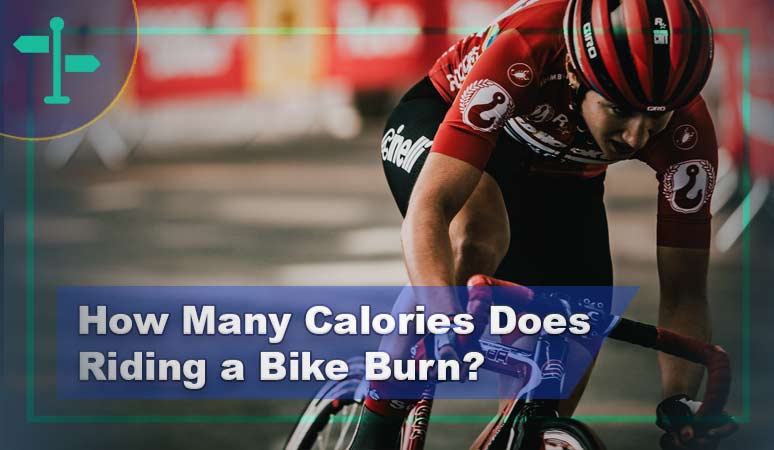If you are thinking about weight loss or simply getting into shape, then coming across the advice of riding a bike to burn calories is pretty normal. But the question of how many calories does riding a bike burns may make you wonder for a while. Should you really try the activity and what type of results can you expect are common concerns to show up in your mind.
So, let’s talk a bit about this stuff today through some informative discussion.
How Many Calories Does Riding a Bike Burn?
There is not a guaranteed figure for calories that you can burn by biking or cycling. However, a few factors or things can impact the amount you burn with a ride. Now to give you some clue, maybe a guessable figure can be provided. Below I’ll try to do exactly that. Keep on Reading…

A Bit More About the Connection of Calorie Burned with Biking
If you want to find a specific number or figure for calories that you’ll burn with biking, then the thing won’t ever be accurate. But when you focus more on the factors that eventually decided your calories loss, you get to understand a better perspective of biking rather than just calorie counting.
Getting a specific calorie amount using equations or depending on GPS devices or apps are actually not going to let you know the guaranteed figure. So, let’s go through these factors that decide what we’re looking for.
First is the wheels. As it may work on downhill freewheeling to burn the least amount of energy. Or maybe you’re going the opposite direction using more of your power, clearly burning more calories.
Another big factor is aerodynamics. This means the direction of the wind or simply speed. Usually, with a bigger frontal surface area, you go from greater aerodynamic drag. For those who have a pretty large body, if they add an upright riding position plus some flappy attire, then definitely biking through the air will need more energy. While a whippet-thin biker will have weight concentrated more on leg wrapped in tight Lycra.
One more criterion is the rolling resistance. Now, this combinedly includes the weight, road surface, tires’ width as well as gravity.
The whole overall fall or climb is what matters the most when we are focusing on weight. If you are a slow rider, then there’s a good chance of burning fat rather than carbohydrate. So, your diet needs to work on keeping carbs low. While if your burning carbs with biking, then the diet needs to help with fat burning.
Calorie Usage While Riding a Bike.
To understand whether or not biking is actually doing anything for you, there’s a need to understand how this activity actually uses calories. Now with biking, you need to use your muscles. This means your muscles will start utilizing the oxygen you’re breathing. It will convert the oxygen into sugars and fats. In some cases, it converts into proteins and ATP. While biking you need a very high amount of ATP.
When you decide to bike intensely, your body becomes obliged to turn the excess fat and carbs into ATP. As it needs to fulfill the sudden demand due to biking. And that’s basically how any activity including the ATP conversion intensity will help in burning carbs and fats.
Better Calorie Burn with Slow & Steady or Fast & Intense?
When you bike at a steady and moderate speed without using resistance, then it’s the aerobic metabolism system being involved. This will aid to make use of glucose efficiency by your body with better heart and lung function.
Not using glucose efficiency often results in metabolic syndrome. Also, it turns a bit risk of pre-diabetes on. With biking harder, you’ll train your muscle fiber to adapt according to demand. With faster speeds, you’ll burn more calories. As the body is using more energy.
Harvard University has some figures regarding this. If you are using a moderate amount of speed, between 12 to 13.9 miles each hour, then you’ll lose almost 300 calories in half an hour. Your weight should be around 155 pounds for this example to be true. If you speed up and go for 14 to 15.9 miles each hour then the total amount of calories burned will be 372.
In Case of Indoor Biking.
The calorie count will slightly vary when you are talking about an indoor bike that is more stationary. It isn’t as dynamic as biking outdoors. However, this can still help. People often opt for spin classes on a suitable schedule.
If you are using a moderate speed between 12 to 13.9 miles each hour, then you’ll be burning around 210 calories every half hour. Your weight should be around 125 pounds. In the case of a person with a 155-pound weight, this calorie burn figure would be 260.
Watch This!
Ending Notes
So, after talking for a while about how many calories does riding a bike burn, we also chatted on the factors involved in biking that are actually more important to know regarding. Technically, if you’re trying to find out about such a thing, it’s basically because you’re willing to lose weight and cycling seems appropriate for your lifestyle to adapt with.
Now if that’s the case, then you can surely think about including this very versatile and easy to engage in activity in your life. Start with biking for 15 minutes, maybe take the bike for grocery shopping or you can literally try using it whenever there’s a need for commuting nearby.
With high-intensity biking, you’ll slowly but surely see some change in your fitness. And even if you decide to keep the intensity low, there are many benefits still included. So, Cheers Up to The Whole Biking Idea, Do Try It!

